Lisa Montonen & Ambivalent Thoughts
Saturday, January 06, 2007
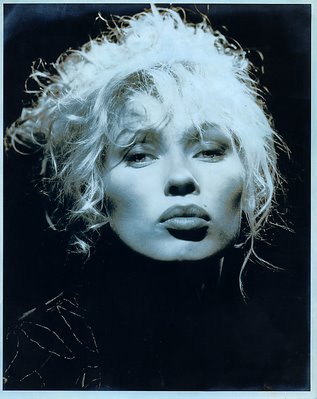 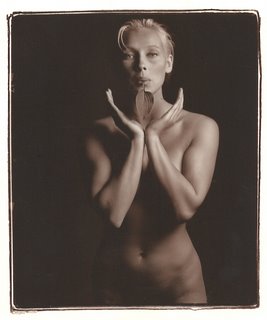
At one time I was going to write a book 1001 Photographic Mistakes & How To Avoid Them. I pursuaded myself that this was a bad idea as I kept inventing new mistakes every day. I would have endless revisions. With film on the wane there are now brand new methods of guaranteeing you will get home with no photographs to show for your efforts. Most of these mistakes involve electronic failures that can happen silently without you ever knowing. These failures (corrupt storage cards and files) are far more complex than the innocent one of opening a processing tank with the lights on. For years I have attempted to avoid failure by using consistent methods that never varied. My Mamiya RB will not function without film in its film backs. The motor drive of my Nikon F-3 has so much torque that there are various ways in which film will not advance (film will jump the sprockets or the gears will tear the sprocket holes) and I have taken 36 pictures in the same frame. After repeated failure with the F-3, I was always extra careful.
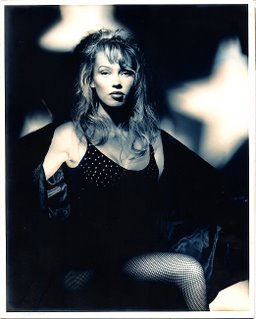
In spite of it all I have had my successes and none can beat my collaboration with Lisa Montonen in 1991. I photographed her twice. In my first efforts I concentrated on using Hollywood glamour lighting of the 40s. I toned the photographs with a chemical blue toner and varied the colour by using a very hot hair dryer.
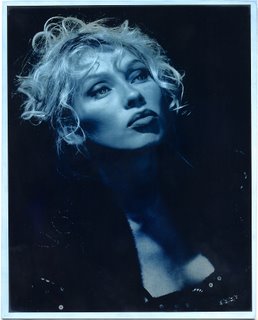
These tricks were the only tricks of an age before Photoshop. The second session involved taking pictures of Lisa with my hostas.
When I look at these photographs I have ambivalent thoughts. I know I can never take photographs like those anymore. Lisa now lives in Los Angeles and I don't plan flying there. They were perfect photographs for me then when I approached (with an innocence of youth) my female subjects as remote but beautiful godesses. It was some time after taking pictures of Lisa that I came to realize that goddesses, they were not. They were like I was.
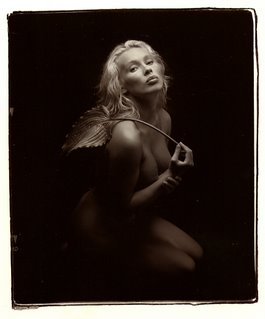
Now I avoid glamour and much of the clothing, if not all of it. I am interested in exploring what it is that attracts me to the undraped woman even after I explain to myself the attraction and the virtue of gardening, reading, eating, listening to Pandolfi or Corelli, and sharing time with my wife, granddaughters and cats. I can think of only one answer that begins to satisfy me, even though there are many more questions that are still unanswered.
From early prehistoric cave dwellers, to painters, sculptors and in the very beginning of photography the nude has always been an obsession with us all.
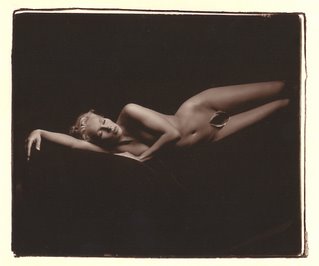
A Failure In Body Parts
Friday, January 05, 2007
It is not usual for me to parade my failures here but here is one example. I modified how I approached my photographic subjects after this one. I sometimes wonder how I would react if I were on the other side of the camera. Lalita was and is a woman who looked like a young Sophia Loren. I took her to Lynn Canyon to excise from my system my inability to see the human foot as a lovely body part. Later in my studio Lalita explained with precise mathematics what areas and what percentages of her body I could record. I took my pictures while keeping my frustration inside. I swore I never would face such a situation again.
Before any subject of mine ever gets to my studio I state my intention in plain English, "If I were to ask you to undrape fully tell me now if there would be any objections." It has served me well.
But I do smile every time I remember what my friend Tony Ricci (who has a fondness for women) told me, "You mean all you did is photograph Lalita's feet? You must be crazy!"
William Deverell - Selenium Toner & My Eureka Moment
Thursday, January 04, 2007
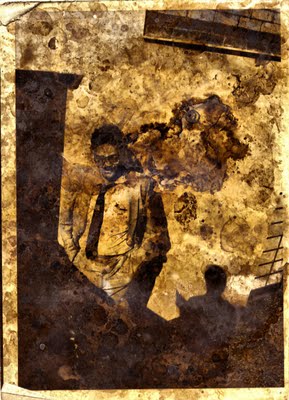 When I run into people I haven't seen for a while they ask me the same question. It is always a variation of, "Are you still....." As if photography is the kind of career you get on and off as you do a cable car. Nobody would have asked William Deverell that question back in 1979 when I photographed him outside Binky's Oyster Bar on Robson. Deverell a career criminal lawyer had just won the Seal First Novel for Needles. I am sure that when people run into Deverell now they never ask him if he is still writing. Perhaps there must be something unstable about being a photographer. I don't think that's the case but photography is most definitely in a state of flux now and nobody can predict how it will all play. Yesterday I went into my darkroom and retrieved empty photo chemical jugs, colour negative processing tanks, colour analyzers for colour printing, a Polaroid instant slide processor, etc. Since Polaroid is all but bankrupt and they have not made instant slide film for years, the handsome processor must become landfill. Much has been said about cameras (be they film or digital) being tools that apply to a problem at hand. The two camps, the digital and the film guys circling the wagons are still involved in heated arguments that parallel those between atheists and believers. They argue that one camera is the better tool over the other. If I don't switch completely to digital it has to do with my inability to raise the funds to purchase a digital back (and all the needed peripherals) for my medium format cameras. I calculate I would need around $50,000. No piddly $6,000 digital Canon can match the detail I get with my film in medium format. Buying one of those would be tantamount to slumming. But I have been thinking about this "a camera is a tool" thing and I have found my Eureka moment. A hammer and a screwdriver are both tools. With one in hand you will bang nails, remove them or tighten screws. In a pinch the screwdriver is good for making holes in the ground for planting seeds. I believe that tools inherently "suggest" to us what we can do with them. One problem with the high end DSLR (Digital Single Lens Reflex) camera is that the ads tell us all they can do untethered to a good light. I must say that for my kind of photography the lighting is all important. Since I purchased my Epson 1640 SU flatbed scanner I have come to believe that my method of photography is a hybrid that incorporates the best of film and digital. But because I can think film (hammer) and/or digital (screwdriver) I find that I have many more choices and methods over the one or the other. While cleaning out the empty bottles in my darkroom I spotted a dirty print that may have fallen many years ago (1979). It is that photograph of Deverell at Binky's. The negatives in my files (I processed them archivally) are in perfect condition and I could make a nice print in my wet darkroom. This version (accidental as it is) scanned with my Epson is a thing of beauty. 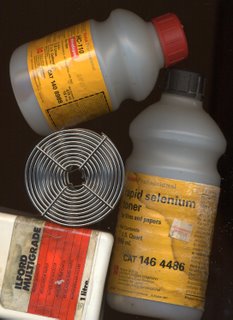 I still use the Ilford Multigrade developer of the picture and I tone them (for permanence) with Kodak selenium toner. I process most of my b+w film with Kodak HC-110, a syrup that resembles the maple kind and was a favourite (the HC-110) of Ansel Adams. The metal reel I use to process my negatives in the same way I did 45 years ago. When horseless carriages started put-putting on the roads nobody was marketing units that would deposit ersatz horse droppings every few kms. Cars almost immediately made a clean break from the past in spite of running boards and coach lights. I think that the digital revolution in photography is in its infancy. It will have arrived when digital photographers stop trying to imitate what can be done with film. 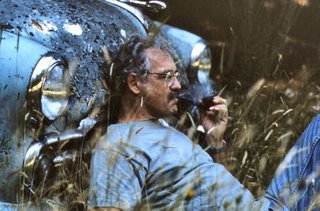 William Deverell William DeverellI hope that I am still around for that. And if people ask me if I am still....I will reply, "Yes I am still a photographer even though I may shoot with a digital camera some day," and to paraphrase St Augustine, "but God, not yet."
Horst Wenzel - Merlin & My Sword Excalibur
Wednesday, January 03, 2007
 Football quarterbacks, after having a successful season, commonly give us highfalutin drivel about how they are nothing and it is all team work. In photography, where Patterson's Law (it states that Murphy was an optimist) is in effect at all times and is guaranteed to ruin your photographic assignment, success can be measured in being able to return to the assigning photo editor with one useable image. A photographer without adequate support staff is no photographer. Since my father told me of King Arthur, Sword Excalibur and Merlin when I was a boy I have had an affinity with the legend. This affinity has made me find a parallel between Sword Excalibur and my Mamiya RB-67 Pro-S with its 140mm lens. When I am behind that combination I know I will not fail. This is, of course, if the camera itself is mechanically sound at the time. That's where Merlin comes in. I have my Merlin. He is camera repairman Horst Wenzel. In our 21st century philosophy of throwing away what does not work, Horst rejects it and upends it further by stating that in any camera he has opened nobody should be able to discern any traces of his entry and repair. I marvel when I watch Horst work. He did not always deal with such tiny gears and levers. Horst was born in Zeven, Germany in 1939. In 1956 he was an apprentice shipbuilder. By 1959 when he moved to Canada he had help build many freighters and oiltankers including the 50,000 ton Esso Guilford at A.G. Weser in Bremen. A few years ago Horst retired from his camera repair company, Vancam Service. He has always specialized in the good cameras: the Leicas, Rolleis, Hasselblads and the odd Alpa. He traveled many times to Europe for authorized training. Horst is now retired and he is busier than ever in his basement shop that has some of the tiniest lathes I have ever seen. Going to Horst's with my beloved Mamiyas (and Nikons, and Pentaxes) is always an adventure into the wonders that I will find there. Horst has built exact scale models of WWII German battleships and cruisers including the Tirpitz, the Prinz Eugen, the Graf Spee and the Scharnhorst. Not only are they built in great detail some of them have working motors and are radio controlled. These are a delight every time I see them but the prize is a painting of his father Hans Wenzel, an officer in the German Army in 1943, that was painted by a friend, Fritz Schindler while both were at the Russian front. While Horst was much too young to participate in the war I would think that he would have ambivalent feelings toward the winning allies and the Russians. The fact is that Horst loves American and British WWII movies. When he is not watching them on the TV that sits to one side of his camera work bench, he also enjoys sports programs that feature female Russian tennis players! In the photo above Horst poses by his father's painting. Horst is holding an unfinished 3-D camera he is building. Yesterday, while getting ready to go to the airport to visit his mother in Zeven who is celebrating a plus 90 birthday, Horst told me, "I have very little time to finish things." That's fine with me and I am sure all those other photographers, would agree, as long as he keeps our swords sharp. And here is another picture of Horst. This is a b+w negative scanned on my flatbed with a sheet of white paper over it. I then reverse the image. 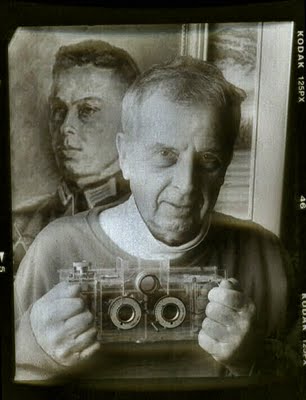
Gordon Slutsky - Shoe Salesman
Tuesday, January 02, 2007
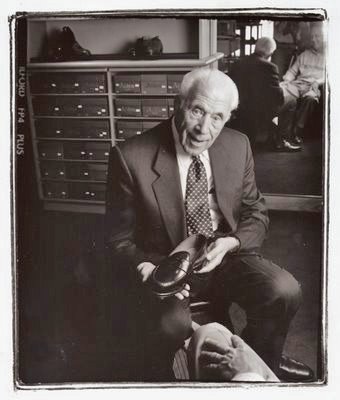 I have a friend, Graham Walker, who wears nice looking shoes that look either new or are polished to a sheen that makes me suspect spit is involved. I introduce him to my other friends as the man who has the shoe fetish. Graham smiles and never disagrees. I might know something about having a shoe fetish that I often keep to myself. By the time I was 15 I was buying wine coloured, cordovan-leather Bostonian loafers at a store in Austin, Texas that sold Hart Schaffner & Marx suits. In 1965 I went into Lopez Taibo on Avenida Corrientes in Buenos Aires to buy a pair of their famous boots. The salesman eyed my sailor suit and rudely asked me if I was in the right store. I produced an American $100 bill (a lot of money in those days) and he immediately smiled and measured my feet. Close to 30 years later I returned to buy a new pair. The same man was working in a much reduced store on Corrientes. He did not remember me. I gave him my name and he came back with a box that had my measurements. I still have those Lopez Taibo boots today. For a while I had expensive taste for good shoes and I shopped at Sheppard Shoes in the original location on West Hastings and when they moved further West. My salesman of choice was Gordon Slutsky. He sold me my last pair of Sheppard shoes in May 98 and a couple of years later the store closed. Gordon Slutsky reminded me of Boris Karloff before he became famous making horror movies. Slutsky was quiet spoken and very gentle. Gordon Slutsky started working with shoes in 1932 in Winnipeg. At the time Winnipeg had the same population as Vancouver and Canadians stood to sing "God Save the King". The brogues that Slutsky sold went for $8 a pair. Sixty six years later (in 1998) a lot of things had changed even though he still sold shoes. In this picture Slutsky is holding an Alden genuine shell cordovan loafer at $675 a pair. On some of the slow days Slutsky got to thinking about cows. He told me, "I see a cow running in the meadow and I see milk. What other purpose does it fulfill? You can make a bunch of leather from it. You get this inanimate stuff, that's all leather is; you cut a pattern and voilà you have a pair of shoes."
A Houston New Year's, Mocambo & Gary Taylor's
Monday, January 01, 2007
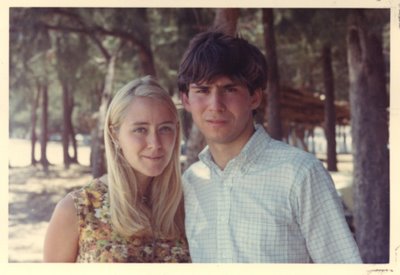
Few know that Houston is an ocean port. Ship channels from the Gulf of Mexico snake all their way to this Texan city. On December 31, 1966, on the stroke of midnight, I was having multiple toasts to my health and the health of all the officers sitting at the captain's table on board Río Aguapey, a ship of ELMA, Empresa Líneas Maritimas Argentinas (the then very active but now defunct Argentine Merchant Marine). We had our white wine with the salad, rosé with the white pasta, red with the entrecote, dry sherry with the soup (Argentines then served soup before the dessert) and moscato (a sweet red) with our flan. Brandy was served with the sopa inglesa (an Argentine version of trifle that has loads of brandy). When the cake came Argentine sparkling wines were opened. With our coffee we had Old Smuggler Scotch. I was returning from my two year stint in the Argentine Navy and the Aguapey was going to deposit me, hitting all the ports on the Gulf of Mexico, a few blocks from my home in Veracruz, Mexico. But my mother had decided to drive to Houston in her blue VW and surprise me. She had been wiring our ship that was anchored off the Houston Port and was getting no replies. How was she to know that the wireless officer was also sitting at our table and that we were all drunk?
I can count with one hand the times I have been drunk in my life. That New Year's in Houston was the first and probably the worst.
By 1989, Rosemary and I stopped having the desire to party at some hotel with a few people we knew and then hug all the people we didn't know at the stroke of midnight. Both of us miss the real New Years of our past together and in particular a couple we had in Veracruz, Mexico. In one of them we weren't married but I had oiled the hinges of my room well in my mother's house on Calle Navegantes. In both occasions the sirens of all the ships so near us in the port of Veracruz and all the others anchored on the gulf made those warm New Years difficult to top. If the nortes weren't blowing it was usually hot enough for us to drive to our favourite beach by the Mocambo Hotel. It was there were we had this picture taken in late December 1967.
 |
| With Gary Taylor |
One of the strangest New Years we ever had was around 1987 at Gary Taylor's Rock Room on Hornby Street. In the picture here you can see Gary Taylor with the not-yet-known body builder, Carla Temple, on the right. Rosemary and I were invited by Gary Taylor to a New Years celebration at his rock room. He liked to invite me because he knew I was a cheap guest who never drank any of his liquor or accepted any of the other high grade rewards he offered his best clientele. The entertainer that evening was Roy Forbes (then known simply as Bim). I was astonished that at midnight he took out a paper from his shirt pocket which had the lyrics of Auld Lang Syne which he obviously did not know. After finishing he sprayed Rosemary and I (we were, unluckily, in the front) with an entire bottle of Möet & Chandon. But the strangest part of the evening were three very young Polish sailors who kept smiling at me. I told Rosemary that I felt uncomfortable and that we should go home. As we were leaving the sailors caught us on our way out and told us in a a terrible broken English that I was the spitting image of Roman Polanski. They asked for my address. For years we received Christmas cards from them.
Veracruz
Veracruz mangoes
The Sugar Plum Fairy & Strawberry Crepes
Sunday, December 31, 2006
  Yesterday Rebecca, Lauren and I went to a performance of Mikko Nissinen's The Nutcracker at the Queen Elizabeth Theatre. It was to be a co-production of Ballet British Columbia and Alberta Ballet but I only spotted three Ballet BC dancers. From our seats up in the nether reaches of the "gallinero" we were still able to hear the nutcracker-grinding sounds by a pleasantly loud Vancouver Symphony Orchestra. This was to be a real test for Lauren(4). It was her first attendance of a full-length ballet. I cannot understand why this usually overlong ballet seemed to cruise along so quickly but it did, very nicely. Even Linda Lee Thomas, the VSO's pianist, would have been glad! Rebecca and I had attended a few Royal Winnipeg Ballet Nutcrackers with Evelyn Hart where we dozed and woke up for the Evelyn Hart parts. Lauren was awake and alert through the whole performance. Perhaps it had to do with our inside connection with the Sugar Plum Fairy. Sandrine Cassini, The Sugar Plum Fairy, was our very favourite classical ballerina, And we knew that after the performance (she was fantastically light) we would join her at Robson's La Vieille France creperie. But we first went to the dressing room. I find it hard to believe that with so much dance talent on stage, the door to the backstage dressing rooms, was devoid of clamoring, giggling and screeching little girls. Nobody was there. We opened the door and entered. We asked for Sandrine and we were told to wait. Not a few seconds later Sandrine appeared all wet and wearing nothing but a blue bath towel and hugged us all. As we walked to the creperie, Lauren kept asking, "Is the Sugar Plum Fairy going to have crepes with us?" I kept answering, "Yes." 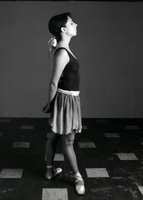 We had strawberries and whipped cream on our crepes and the Sugar Plum Fairy opted for a toasted ham sandwich.
|

























